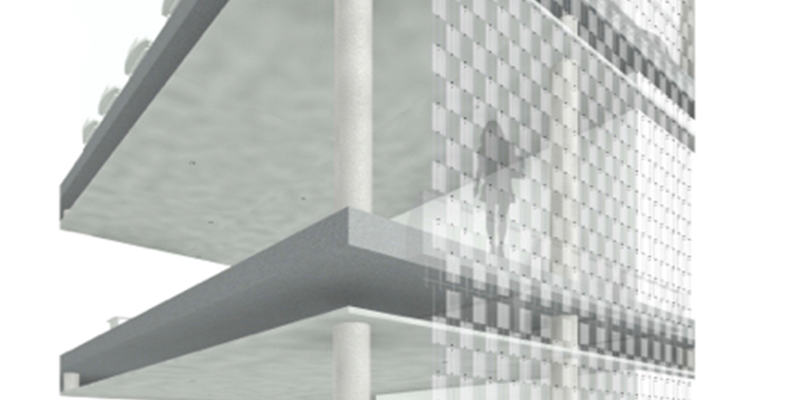Downloads
DOI:
https://doi.org/10.7480/jfde.2019.1.2785Keywords:
microfluidic, thermal transport, absorber, solar, geometry matrix, bio-inspiredAbstract
The glazed envelopes on buildings play a major role in operational energy consumption as they define the boundary conditions between climate and thermal comfort. Such a façade is viewed as an uncontrolled load that sets the operational performance requirements for artificial lighting and air-cooling mechanical systems. This is in contrast to nature, which has evolved materials with the ability to learn and adapt to a micro-environment through self-regulation using materials that are multifunctional, formed by chemical composition in response to solar load. Leaf vasculature formations are of particular interest to this paper. Through leaf maximisation of daylight capture, the total leaf area density and angular distribution of leaf surfaces define the tree structure.
This paper will define an approach to simulate nature to advance a microfluidic platform as a dynamic NIR absorber for solar modulation: a transformable network of multi-microchannel geometry matrix structures for autonomous transparent surfaces, for real time flow management of conductivity. This is realised through active volumetric flows within a capillary network of circulation fluidics within it, through it, and out of it for energy capture and storage, the cycle of which is determined through precise management of heat flow transport within a material. This advances transparent façades into an energy system for heat load modulation nested to climate and solar exposure, which is demonstrated in this paper.
How to Cite
Published
Issue
Section
License
Copyright (c) 2019 Mark Edward Alston, Uta Pottgiesser, Ulrich Knaack

This work is licensed under a Creative Commons Attribution 4.0 International License.
Authors or their institutions retain copyright to their publications without restrictions.
References
Alston, M.E. (2017). Optimal Microchannel Planar Reactor as a Switchable Infrared Absorber: (invited manuscript) MRS Advances. Nanomaterials. Vol. 2, 14, pp. 783-789
Alston, M.E. & Barber, R. (2016). Leaf venation as a resistor to optimize a switchable IR absorber. Scientific Reports 6, 31611; doi: 10.1038/srep31611.
Blonder, B.,Violle, C., Bentley, L. P., & Enquist, B. J. ( 2011). Venation networks and the origin of the leaf economics spectrum. Ecology Letters. 14, pp. 91–100.
Chow, T.T., Chunying, L., & Zhang, L., (2011) Thermal characteristics of water-flow double-pane window. International Journal of Thermal Sciences, 50: 140-148.
Chow, T.T., & Chunying, L., (2013) Liquid-filled solar glazing design for buoyant water-flow. Building and Environment 60: 45-55.
Dengler, D., & Kang, J. (2001). Vascular Patterning and Leaf Shape. Plant Biology, Elsevier Science. 4, pp. 50-56.
European Parliament Directive 2010/31/EU (2010). European Parliament and of the Council of 19 May 2010 on the energy performance of buildings (recast), Official Journal of the European Union 53 (2010) 13.
Feugier, F.G., Mochizuki, A., & Iwasa, Y. (2005). Self organization of vascular systems in plant leaves: inter-dependent dynamics of auxin flux and carrier proteins. Journal of Theoretical Biology . 236, pp. 366–375.
Hens, H. (2011). Applied Building Physics, Boundary Conditions, Building Performance and Material Properties. Berlin: Ernst + Sohn .
Katifori, E., Szollosi, G.J., & Magnasco, M.O. (2010). Damage and Fluctuations Induce Loops in Optimal Transport Networks, Physical Review letter, PRL 104,04874.
Knaack, U., Klein, T., Bilow, M., & Auer, T. (2014). Façades, Principles of construction. Basel: Birkhäuser Verlag GmbH.
Lopez, T., Gimenez-Molina, C (2012) Influence of double glazing with circulating water chamber on a thermal energy saving in buildings, Energy and Buildings, 56, pp.56-65
Nestle, N., Pulbere, S., & Alston, M.E. (2018), Possible benefits of capillary flow glazing in translucent wall elements, Facade 2018 – Adaptive!, Proceedings of the COST Action TU1403 – Adaptive Facades Network Final Conference, Luzern.
Oh, K.W., Lee, K., Ahn, B., & Furlani, E.P. (2010). Design of Pressure-driven Microfluidic Networks using Electric Circuit Analogy. Lab on a Chip.12, pp.515-545.
Stopper, J., Boeing, F., & Gstoehl, D., (2013) FluidGlass Façade Elements: Influences of dyeable Liquids within the Fluid Glass Façade, Energy Forum on Solar Building Skins, Bressanone.
Turing, A. M. (1952). The Chemical Basis of Morphogenesis, Philosophical Transaction of the Royal Society of London, Series B, Biological Science. 237, 641,pp 37-72.
